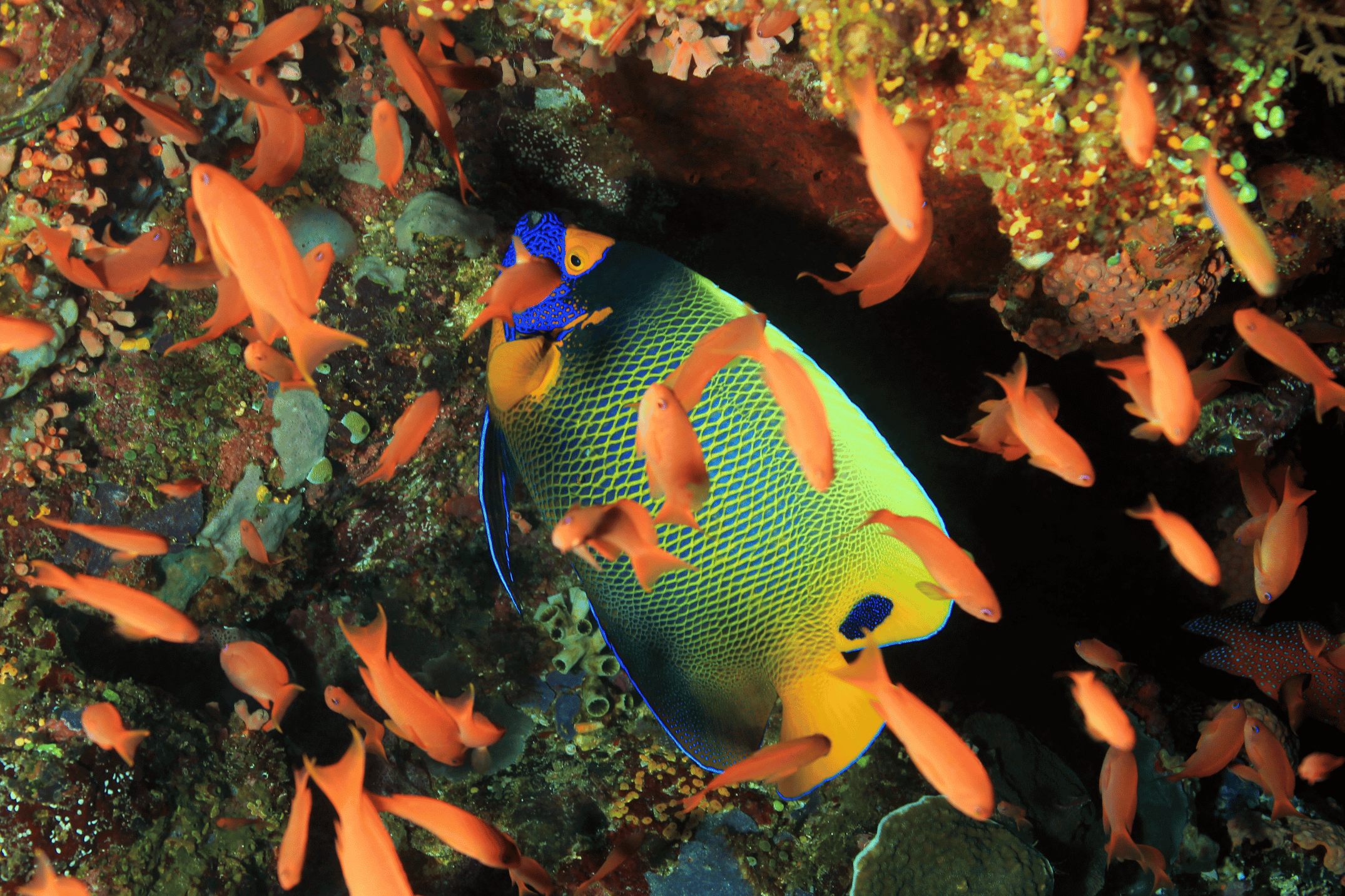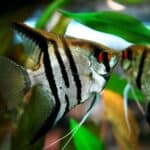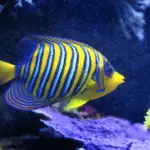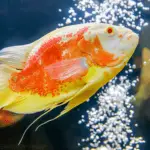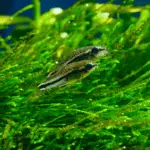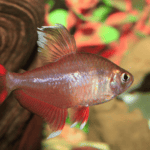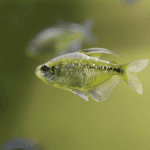Keeping angelfish in a community aquarium brings a majestic elegance to any tank, but it requires meticulous selection of their tank mates. As a semi-aggressive species, angelfish thrive with companions that respect their space and have similar care requirements. Understanding their temperaments is essential—angelfish exhibit a mix of peaceful and territorial behaviors that can fluctuate depending on the tank environment and hierarchy.
To foster a harmonious aquarium, we must consider the habitat preferences of angelfish. These freshwater fish originate from the slow-moving, tropical waters of the Amazon Basin and prefer densely planted tanks with plenty of room to swim. The tank layout should allow them the freedom to exhibit natural behaviors while providing plenty of hiding places for both the angelfish and their tank mates to coexist without stress.
Key Takeaways
- Angelfish require tank mates that complement their semi-aggressive nature and space requirements.
- A well-structured tank environment mimicking their natural habitat promotes harmony within a community aquarium.
- Regular monitoring of feeding behaviors and water quality is critical to the health of angelfish and their companions.
Understanding Angelfish Behavior
When we select tank mates for angelfish, it’s vital to understand their behavior. This includes recognizing their social dynamics and breeding habits which are significant in ensuring a harmonious aquarium.
Temperament and Social Dynamics
Angelfish are generally peaceful but can become aggressive if they feel threatened or are competing for resources. We recognize them as semi-aggressive, meaning their temperament can vary. Most often, angelfish display a hierarchy within the tank, showing more dominance as they mature.
- Hierarchy: Often established through mild aggression.
- Companionship: Prefer to swim with other angelfish; can become lonely without social interaction.
When considering companions, we must seek social fish that do not provoke the angelfish’s territorial instincts.
Territorial and Breeding Habits
During breeding periods, angelfish become especially territorial. They form strong pair bonds and can guard their spawning area aggressively against intruders.
- Breeding Pair: Once formed, they remain together and defend their chosen territory.
- Spawning Sites: Prefer broad-leaved plants or flat, vertical surfaces to lay eggs.
It is our responsibility to ensure enough space for each angelfish pair to establish territory, reducing stress and potential conflict within the community tank.
Creating the Ideal Angelfish Habitat
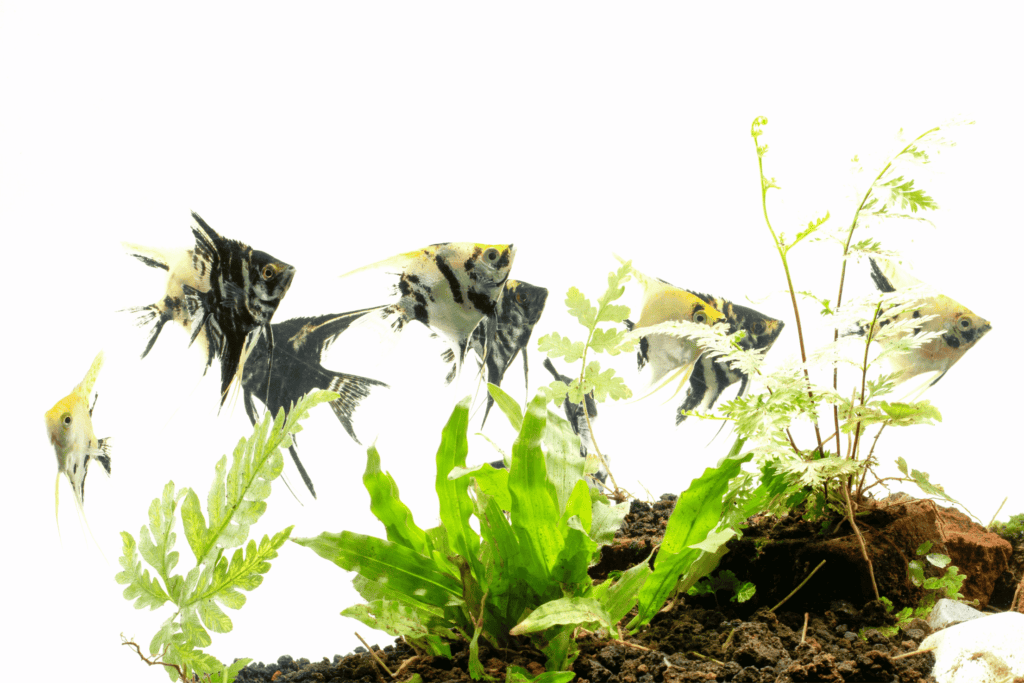
To ensure the thriving of angelfish, we must carefully consider tank size and water parameters as well as substrate and layout. Proper attention to these details can significantly contribute to the health and longevity of these fish.
Tank Size and Water Parameters
Aquarium Size: For angelfish, we recommend a tank size of at least 29 gallons for a small group, with an additional 10 gallons per extra fish to provide ample swimming space. This volume allows for stable water conditions and sufficient area for angelfish to establish territories.
| Water Parameter | Ideal Range |
|---|---|
| pH | 6.0 – 7.5 |
| Water Temperature | 76°F – 86°F (24°C – 30°C) |
| Water Hardness | 3° to 8° dKH (soft water) |
Water Conditions: We maintain a pH between 6.0 and 7.5, which is optimal for angelfish health. The water temperature should be kept warm, between 76°F and 86°F. Soft water with a hardness range of 3° to 8° dKH is preferable. It’s vital to use a reliable testing kit to monitor these parameters frequently.
Substrate and Aquatic Layout
For the substrate, we choose a fine-grained, sandy substrate that mimics the natural environment of angelfish. It should be gentle on their delicate fins and allow for easy rooting of plants.
Aquatic Layout: Our aim is to create an underwater world that provides both aesthetic appeal and functionality. Here’s how we approach it:
- Plants: Tall and broad-leaved plants, which give angelfish places to hide and spawn. Live plants also help maintain water quality.
- Decor: Smooth-edged rocks and driftwood can be used to create natural boundaries and hiding spots without risk of injury to the fish.
Our set-up of the aquarium, considering both substrate choice and layout, ensures a balance between beauty and the specific needs of angelfish.
Choosing Compatible Tank Mates for Angelfish
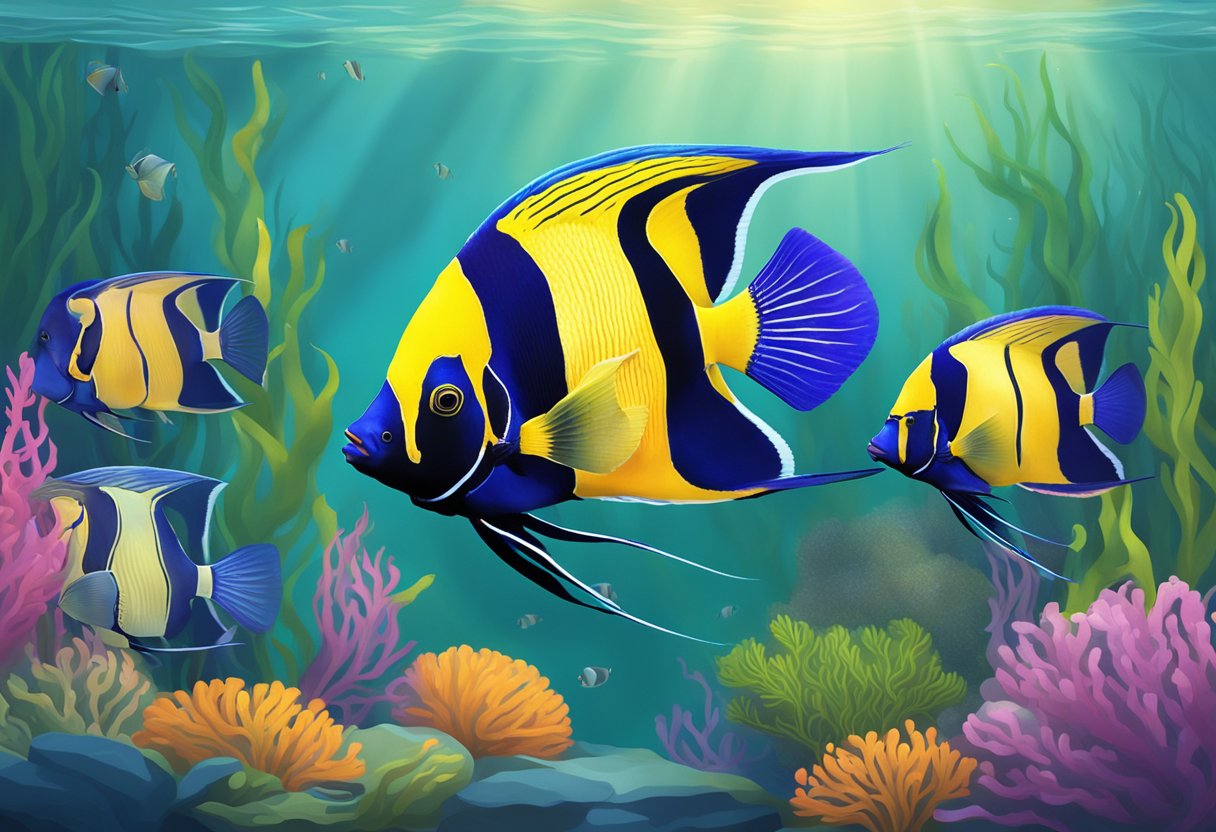
When selecting tank mates for angelfish, we must focus on matching their peaceful nature, ensuring size compatibility, and considering different levels of the tank they inhabit.
Peaceful Community Fish
In a community tank, we prioritize harmony among the inhabitants. Peaceful fish that maintain a serene environment are essential. Smaller, non-aggressive species such as neon tetras and rummy nose tetras are well-suited due to their gentle nature and tend to keep to themselves or in small schools, which helps prevent confrontation with the territorial angelfish. Additionally, guppies and platy fish, known for their colorful appearance and peaceful demeanor, make excellent companions.
- Recommended Peaceful Community Fish:
- Neon Tetras
- Rummy Nose Tetras
- Guppies
- Platy Fish
Similar Sized and Non-Aggressive Species
Tank mates that are of a similar size to angelfish are less likely to be bullied or seen as prey. Dwarf gouramis and mollies embody the right combination of peacefulness and size, making them suitable tank mates for angelfish. It’s crucial to ensure that these species are non-aggressive to maintain a tranquil tank environment.
- Optimal Similar Sized Species:
- Dwarf Gourami
- Mollies
Bottom-Dwelling Companions
The bottom layers of the tank provide a different microhabitat and can be occupied by species that dwell on or near the substrate without disturbing angelfish. Corydoras catfish offer a peaceful bottom-dwelling option and are excellent at keeping the tank clean. Kuhli loaches, with their eel-like appearance, are another amiable choice, and they’re known for their ability to coexist with angelfish. Bristlenose pleco provide algae-cleaning services and have a calm nature that aligns well with angelfish.
- Compatible Bottom-Dwelling Companions:
- Corydoras Catfish
- Kuhli Loaches
- Bristlenose Pleco
Feeding and Diet Requirements
When we introduce angelfish to a community tank, we must consider their diet and feeding habits to ensure all fish thrive without food competition.
Diet Considerations for a Diverse Aquarium
Angelfish are tropical fish that require a varied diet consisting of flake food, live food, and frozen food to fulfill their nutritional needs. We must ensure that the diet supports their immune system and growth. A proper feeding schedule for the entire aquarium community typically includes:
- Flake Food: Daily feeding, high in protein.
- Frozen Food: Such as bloodworms, fed several times a week.
- Live Food: Brine shrimp can be added occasionally for variety.
It’s crucial to observe the feeding behaviors of other species within the same tank to adjust portions and feeding frequency. Livebearers, for example, are also tropical fish often found in community tanks that share similar dietary requirements. By ensuring a variety of food sources, we support a balanced diet for all.
Avoiding Competition over Food
Competition for food can lead to stress and aggression in an aquarium. We can minimize this by:
- Feeding in Multiple Locations: Distributing food across the tank allows all fish, including slower-moving species, to eat without stress.
- Appropriate Portion Sizes: Overfeeding can lead to competition and water quality issues. We must provide enough food that can be consumed within a few minutes.
- Timing Feedings: Synchronous feeding times can reduce aggressive behavior. All tank inhabitants should have access to food at the same time to reduce the chase for resources.
By understanding the specific feeding requirements and habits of angelfish and their tank mates, we can create a harmonious environment with reduced food competition.
Monitoring Water Quality and Tank Health
Ensuring the health of our angelfish begins with consistent monitoring of water quality and tank conditions. It’s critical to maintain optimal environments when we introduce new tank mates or adjust our tank setup.
Regular Maintenance and Water Testing
We perform regular maintenance and water testing to keep the aquarium environment stable. Water quality is the cornerstone of a healthy tank and must be checked weekly. We look for specific parameters such as:
- pH levels: 6.5 – 7.5
- Ammonia: 0 ppm
- Nitrite: 0 ppm
- Nitrate: < 40 ppm
- Water hardness: 3-8 dGH
- Water temperature: 78-84°F (25.5-29°C)
For accuracy, we use reliable water testing kits. Regular water changes of about 20-25% biweekly help us manage these parameters.
Addressing Changes and Introducing New Tank Mates
When we notice shifts in the water quality or temperature, we take immediate steps to rectify them. Before introducing new tank mates to our angelfish, we ensure they are compatible and the tank environment is conducive to all species’ well-being. Our checklist for introducing new tank mates includes:
- Quarantine new fish: This prevents the spread of diseases.
- Acclimate new fish: Gradually adjust them to water temperature and chemistry.
- Monitor behavior: Watch for signs of stress or aggression after introduction.
Addressing changes proactively helps us maintain a harmonious and healthy ecosystem within our aquarium.
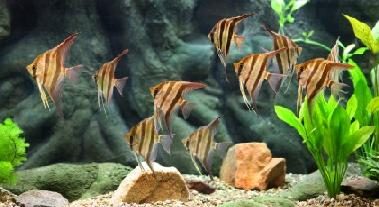
Frequently Asked Questions
In our experience, choosing the right tank mates for angelfish is key to maintaining a harmonious aquarium. We address common inquiries to help ensure your angelfish and their companions thrive together.
What are suitable companions for angelfish in a community aquarium?
In our view, suitable companions for angelfish include small to medium-sized peaceful fish such as dwarf corydoras, platies, and smaller rasbora species. We avoid placing highly aggressive or fin-nipping species with angelfish.
How many angelfish can coexist peacefully in one tank?
We generally recommend that anywhere from one to six angelfish can coexist peacefully in a tank, provided it is sufficiently spacious and well-structured with hiding spots to prevent territorial behavior.
What are the recommended tank conditions for housing angelfish with other fish?
We advise maintaining a tank temperature of 76 to 84 degrees Fahrenheit, a pH level between 6.8 and 7.8, and soft to moderately hard water. It’s crucial to ensure these conditions are also suitable for the angelfish’s tank mates.
Can tetras and angelfish be kept together in the same aquarium?
Yes, tetras and angelfish can often be kept together, as many tetras are peaceful and can share similar water conditions. We especially recommend larger tetras such as black skirts or rummy noses to prevent angelfish from seeing them as prey due to their smaller size.
What size tank is needed to accommodate angelfish and their tank mates?
We assert that a minimum tank size of 20 gallons is appropriate for a pair of angelfish, with an additional 10 gallons for each additional angelfish. Sufficient space for swimming and territories for both angelfish and their tank mates is necessary.
Are there compatible cichlid species that can live with angelfish without causing stress?
There are cichlid species compatible with angelfish; for example, dwarf cichlids like the Apistogramma can be appropriate tank mates. We select cichlids carefully, considering temperament and environmental needs to avoid stress and competition.
